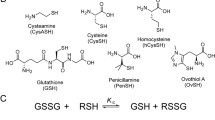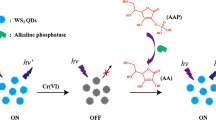Summary
2,2′-dihydroxy-6,6′-dinaphthyldisulfide (DDD) reacts with both protein thiol groups and with protein disulfides (Nöhammer 1977). By varying the pH of the DDD-reaction, as well as the reaction times, the complex reaction became specific with respect to the histochemical demonstration of protein-SH groups. Furthermore, the application of the histochemical DDD-reaction following quantitative blockade of the protein-SH groups enabled the demonstration of distinctive DDD-reactive disulfides. The specifity and the extent of the different histochemical DDD-staining methods were investigated by comparing macroscopically determined values of the protein-SH-contents, and the contents of the different kinds of disulfides in Ehrlich-ascites-tumor cells (EATC) (Modig 1968; Hofer 1975), with microspectrometrical values determined with the MCN-method of Nöhammer et al. (1981), and with microspectrometrical values measured on EATC after staining with the modified DDD-methods. Also, the method for the histochemical demonstration of protein-SH with DDD after the reduction of the disulfides with thioglycolate was investigated and conditions were found by which the protein-SH content could be determined quantitatively with DDD and Fast blue B after the reduction of the disulfides. With the aid of the MCN-method (Nöhammer et al. 1981), the intracellular disulfide interchange reaction was investigated, leading to pH-dependent changes of the SH-SS-ratio of fixed cells during their incubation in aqueous media. In addition the possibility of protein loss during the long incubation times of the fixed cells in the DDD-solutions was investigated. For the quantitative microscpecrometrical determination of the protein content of EATC the so-called tetrazonium-coupling method, optimized by Nöhmmer (1978) and calibrated by Nöhammer et al. (1981), was used.
Similar content being viewed by others
References
Andersson L-O (1966) The heterogeneity of bovine serum albumin. Biochim Biophys Acta 117:115–133
Andersson L-O, Berg G (1969) Hydrolysis of disulfide bonds in weakly alkaline media. Biochim Biophys Acta 192:534–536
Bahr GF (1966) Introduction to the cytochemistry of sulfhydryl and disulfide groups. In Wied GL (ed) Introduction to quantitative cytochemistry. Academic Press, New York
Barnard EA (1961) Acylation and diazonium coupling in protein cytochemistry with special reference to the benzoylation-tetrazonium method. In: Danielli JF (ed) General cytochemical methods. Academic Press, New York
Barrnett JR, Seligman AM (1952) Histochemical demonstration of protein-bound SH-groups. Science 116:323–327
Barrnett JR (1953) Histochemical distribution of protein sulfhydryl groups. J Natl Cancer Inst 13:905–925
Barrnett JR, Seligman AM (1954) Histochemical demonstration of sulfhydryl and disulfide groups of protein. J Natl Cancer Inst 14:769–792
Boross L (1969) Secondary SH-disulfide exchange reactions following the modification of nucleophilic SH-groups in D-glyceraldehyde-3-phosphate dehydrogenase with DTNB (5,5′-dithiobis-(2-nitrobenzoate)). Acta Biochim Biophys Acad Sci Hung 4:57–69
Brocklehurst K, Kierstan M, Little G (1972) The reaction of papain with Ellman's reagent (5,5′-dithiobis-(2-nitro-benzoate)dianion). Biochem J 128:811–816
Brocklehurst K, Little G (1973) Reactions of papain and of low-molecular-weight thiols with some aromatic disulfides: 2,2′-dipyridyl disulfide as a conventient active-site titrant for papain even in the presence of other thiols. Biochem J 133:67–80
Carmichael DF, Keefe M, Pace M, Dixon JE (1979) Formation of interchain disulfide bonds in Bence Jones proteins and Fab(t) fragments of immunoglobulin G through thiol-disulfide interchange. J Biochem 84:1475–1483
Cecil R, Loening UE (1960) The reaction of disulfide groups of insulin with sodium sulphite. Biochem J 76:146–155
Cecil R, Wake RG (1962) The reactions of inter- and intrachain disulfide bonds in proteins with sulphite. Biochem J 82:401–406
Ellman GL (1959) Tissue sulfhydryl groups. Arch Biochem Biophys 82:70–77
Esterbauer H (1972) Beitrag zum quantitativen histochemischen Nachweis von Sulfhydrylgruppen mit der DDD-Färbung. I. Untersuchung der Farbstoffe. Acta Histochem 42:351–355
Esterbauer H (1973) Beitrag zum quantitativen histochemischen Nachweis von Sulfhydrylgruppen mit der DDD-Färbung. II. Bestimmung von SH-Gruppen in unlöslichen Proteinen. Acta Histochem 47:94–105
Esterbauer H, Nöhammer G, Schauenstein E, Weber P (1973) Beitrag zum quantitativen histochemischen Nachweis von Sulfhydrylgruppen mit der DDD-Färbung. III. Quantitative cytospektrometrische Bestimmungen an Ehrlich-Ascites-Tumorzellen. Acta Histochem 47:106–114
Federici G, Duprè S, Matarese RM, Solinas SP, Cavallini D (1977) Is the alkaline cleavage of disulfide bonds in peptides an α-β elimination reaction or a hydrolysis?. Int J Peptide Protein Res 10:185–189
Federici G, DiCola D, Sacchetta P, Dillio C, Del Boccio G, Polidoro G (1978) Reversible inactivation of tyrosine aminotransferase from guinea pig liver by thiol and disulfide compounds. Biochem Biophys Res Commun 81:650–655
Friedman M (1973) The chemistry and Biochemistry of the sulfhydryl group in amino acids, peptides and proteins. Pergamon Press, Oxford
Hofer E (1975) Wirkung SH-modifizierender Reagentien auf den synchronen Mitosezyklus von Physarum polycephalum. Doctors thesis, University Graz, Austria
Hupe DJ, Wu D (1980) Effect of charged substituents on rates of the thiol-disulfide interchange reaction. J Org Chem 45:3100–3103
Isaacs J, Binkley F (1977) Glutathione dependent control of protein disulfide — sulfhydryl content by subcellular fractions of hepatic tissue. Biochim Biophys Acta 497:192–204
Jensen EV (1959) Sulfhydryl-disulfide interchange. Science 130:1319–1323
Jocelyn PC (1972) Biochemistry of the SH group. Academic Press, London
Maddy AH (1961) 1-fluoro-2:4-dinitrobenzene as a cytochemical reagent. In: Danielli JF (ed) General cytochemical methods, vol 2. Academic Press, New York
Mannervik B, Axelsson K (1980) Role of cytoplasmic thioltransferase in cellular regulation by thiol-disulfide interchange. Biochem J 190:125–130
Modig H (1968) Cellular mixed disulphides between thiols and proteins, and their possible implication for radiation protection. Biochem Pharmacol 17:177–186
Modig H, Révész L (1968) Cellular sulphydryl levels and the effect of two mercaptopyridoxine derivatives with differential radioprotective action. Arzneimittelforsch 18:1156–1157
Nöhammer G, Schauenstein E, Weber P (1973) Quantification of selective bindung of 4-hydroxypentenal to structural protein thiols in Ehrlich tumor cells. An illustration of the efficiency of cytospectrometric evaluation of cytochemical results. J Histochem Cytochem 21:1082–1089
Nöhammer G (1977) Quantitative cytospectrometrische Bestimmung von Proteinsulfhydrylgruppen und von reaktiven Disulfidgruppen mit der DDD-Echtblau B-Färbung an Ehrlich-Ascites-Tumorzellen. Acta Histochem 59:317–328
Nöhammer G (1978) Die cytospectrometrische Proteinbestimmung mit der Tetrazonium-Kupplungsreaktion. I. Optimierung der Färbemethode. Acta Histochem 61:317–329
Nöhammer G, Desoye G (1981) The cytospectrophotometrical determination of proteins by the tetrazonium coupling reaction. II. Calibration of the staining method. Acta Histochem 68:103–110
Nöhammer G, Desoye G, Koschsorur G (1981) Quantitative cytospectrophotometrical determination of the total protein thiols with “Mercurochrom”. Optimization and calibration of the histochemical reaction. Histochemistry 71:291–300
Olinescu R, Uleu C (1974) Studies on the SH-SS equilibrium in biological media. V. On the determination of sulfhydryl groups in tissue. Rev Roumaine Biochim 11:283–289
Pearse AGE (1968) Histochemistry theoretical and applied, vol 1. Churchill, London
Rindler R, Schauenstein E (1970) Über den Einfluß von 4-Hydroxypentenal auf den Gehalt proteingebundener und nicht-proteingebundener SH-Gruppen in Normal- und Tumorzellen. Z Naturforsch 25:739–744
Robyt JF, Ackerman RJ, Chittenden CG (1971) Reaction of protein disulfide groups with Ellman's reagent: A case study of the number of sulfhydryl and disulfide groups in Aspergillus oryzae α-amylase, papain and lysozyme. Arch Biochem Biophys 147:262–269
Ryle AP, Sanger F (1955) Disulfide interchange reactions. Biochem J 60:535–540
Sillevis Smitt PAE, James J, Wisse JH (1968) The DDD-method in the cytophotometric quantitative estimation of protein-bound sulfhydryl groups in palatal smears. Acta Histochem 33:53–58
Steven FS, Podrazky V (1978) Evidence for the inhibition of trypsin by thiols. The mechanism of enzyme-inhibitor complex formation. Eur J Biochem 83:155–161
Torchinskii YuM (1974) Sulfhydryl and disulfide groups of proteins. Consultants bureau, New York
Torchinskii YuM (1981) Sulfur in proteins. In: Metzler D (ed). Pergamon Press, Oxford
Weber P (1974) Cytospektrometrische Bestimmung der Protein-SH-Gruppen in Tumor- und Normalzellen. Doctors Thesis, University Graz. Austria
Author information
Authors and Affiliations
Additional information
Dedicated to Prof. Dr. E. Ziegler on the occasion of his 70th birthday
Rights and permissions
About this article
Cite this article
Nöhammer, G. Quantitative microspectrophotometrical determination of protein thiols and disulfides with 2,2′-dihydroxy-6,6′-dinaphthyldisulfide (DDD). Histochemistry 75, 219–250 (1982). https://doi.org/10.1007/BF00496014
Received:
Issue Date:
DOI: https://doi.org/10.1007/BF00496014




